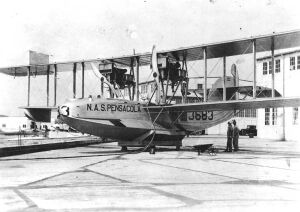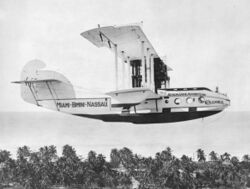Engineering:Felixstowe F5L
| F5L | |
|---|---|

| |
| Curtiss F5L patrol plane at Pensacola Naval Air Station | |
| Role | Military flying boat |
| National origin | United Kingdom |
| Manufacturer | Naval Aircraft Factory (137) Curtiss Aircraft (60) Canadian Aeroplanes Limited (30) |
| Designer | John Cyril Porte |
| First flight | 15 July 1918[1] |
| Introduction | November 1918 |
| Retired | 1928 |
| Primary users | United States Navy Aeromarine Plane and Motor Company (Aeromarine 75) Atlantic Coast Airways Corporation of Delaware |
| Number built | 227 |
| Developed from | Felixstowe F.5 |
| Variants | Naval Aircraft Factory PN |
The twin-engine F5L was one of the Felixstowe F series of flying boats developed by John Cyril Porte at the Seaplane Experimental Station, Felixstowe, England, during the First World War for production in America.
A civilian version of the aircraft was known as the Aeromarine 75.
Design and development

Porte had taken the Curtiss H-12, an original design by the American Glenn Curtiss, and developed it into a practical series of flying boats at the Felixstowe station. They then took their F.5 model and further redesigned it with better streamlining, a stronger hull using veneer instead of doped linen and U.S.-built 330 hp (later 400 hp) Liberty 12A engines. The prototype was built and tested in England and the design then taken over by the Naval Aircraft Factory, Philadelphia, where further modifications were made to suit their production methods under wartime conditions.[2] The American-built version was also known as the Curtiss F5L and (in civilian operation) as the Aeromarine 75.
The F5L was built by the Naval Aircraft Factory (137), Curtiss (60) and Canadian Aeroplanes Limited (30). Some were converted for civilian use by the Aeromarine Plane and Motor Company in 1919.
Operational history
The F5L entered U.S. service at the end of the war and was the U.S. Navy's standard patrol aircraft until 1928, when it was replaced by the PN-12.
In civil service, named the Aeromarine 75, the Felixstowe F5L could accommodate 10 passengers and was operated by Aeromarine Airways on flights from Key West to Havana, carrying the first U.S. Post Office international air mail on flights from New York City to Atlantic City, and from Cleveland to Detroit. The first in-flight movie screened in an Aeromarine 75 during the Pageant of Progress Exposition, Chicago , August 1921.
A further civil conversion for the Atlantic Coast Airways Corporation of Delaware was reported to accommodate 25 passengers in August 1928, with talkies by First National Pictures run as a test on the inaugural flight. The airline bought about six ex-U.S. Navy aircraft and advertised a service between Montreal , Boston, Newport, New York, Atlantic City, Charleston, Miami and Havana.[3][4][5]
Operators
 Argentina
Argentina
- Argentine Naval Aviation
 Brazil
Brazil
- Brazilian Naval Aviation – Curtiss F5L
 United States
United States
- United States Navy
- Aeromarine Airways
- Atlantic Coast Airways Corporation of Delaware
Accidents and incidents
On 13 January 1923, the Aeromarine Airways Aeromarine 75 Columbus suffered engine failure during a flight from Key West to Havana and landed in the Florida Strait. Buffeted by 10-to-15-foot (3-to-4.5-metre) waves, its hull began to fill with water. Four passengers died, but the ferry ship H. M. Flagler saved the other three passengers and both crew members.[6]
Survivors
Both a hull and float from a US Navy F5L are preserved at the National Air and Space Museum (Smithsonian). The hull is only partially skinned with wood to reveal structure. Both artifacts are presently in storage and not available for public display.[7]
Specifications
Data from Flight 31 July 1919,[2] Smithsonian National Air and Space Museum:Felixstowe[7]
General characteristics
- Crew: 4
- Capacity: 5,224 lb (2,370 kg) useful load
- Length: 49 ft 4 in (15.04 m)
- Upper wingspan: 103 ft 9.25 in (31.6294 m)
- Lower wingspan: 74 ft 4 in (22.66 m)
- Height: 18 ft 9.25 in (5.7214 m)
- Wing area: 1,394 sq ft (129.5 m2)
- Empty weight: 8,720 lb (3,955 kg)
- Gross weight: 14,334 lb (6,502 kg)
- Powerplant: 2 × Liberty L-12A V-12 water-cooled piston engines, 400 hp (300 kW) each
- Propellers: 2-bladed fixed-pitch propellers
Performance
- Maximum speed: 90 mph (140 km/h, 78 kn)
- Cruise speed: 74 mph (119 km/h, 64 kn)
- Stall speed: 57 mph (92 km/h, 50 kn)
- Range: 830 mi (1,340 km, 720 nmi)
- Rate of climb: 260 ft/min (1.3 m/s)
- Time to altitude: 2,600 ft (792 m) in 10 minutes
- Wing loading: 9.5 lb/sq ft (46 kg/m2)
Armament
- Guns: 2 x machine guns
- Bombs: provision for bombs
See also
Related development
Aircraft of comparable role, configuration and era
- Phoenix P.5 Cork
- Vickers Valentia
- Supermarine Swan
- English Electric Kingston
- Hiro H1H
- Supermarine Southampton
References
- ↑ 1.0 1.1 Molson, Kenneth M. (1978). "The Felixstowe F5L". Cross & Cockage Great Britain Journal 9 (2): 49, 52. http://www.seawings.co.uk/F5L-article-Molson.htm. Retrieved 7 July 2017.
- ↑ 2.0 2.1 "USA Navy F-5-L Flying Boat". Flight XI (No.31) (553): 1024–1026. 31 July 1919.
- ↑ "Travellers by Airplane to Hear Sound Pictures". San Antonio Express. 24 August 1928. https://sep.turbifycdn.com/ty/cdn/scripophily/atlanticcoastnews1.jpg.
- ↑ Larsson; Zekria, Björn; David (9 April 2004). "Atlantic Coast Airways". Airline Timetable Images. https://www.timetableimages.com/ttimages/acal.htm.
- ↑ Fortier, Rénald (9 April 2018). "The costliest sandwich shop on planet Earth, Part 2". Ingenium. https://ingeniumcanada.org/channel/articles/the-costliest-sandwich-shop-on-planet-earth-part-2.
- ↑ Ranter, Harro. "ASN Aircraft accident Aeromarine 75 registration unknown Havana, Cuba". http://aviation-safety.net/database/record.php?id=19230113-0.
- ↑ 7.0 7.1 "Felixstowe (NAF) F-5-L (hull only)". http://www.nasm.si.edu/research/aero/aircraft/felixstowe.htm.
Bibliography
- Bruce, J.M. "The Felixstowe Flying-Boats: Historic Military Aircraft No. 11 Part 1". Flight, 2 December 1955, pp. 842–846.
- Bruce, J.M. "The Felixstowe Flying-Boats: Historic Military Aircraft No. 11 Part 2". Flight, 16 December 1955, pp. 895–898.
- Bruce, J.M. "The Felixstowe Flying-Boats: Historic Military Aircraft No. 11 Part 3". Flight, 23 December 1955, pp. 929–932.
- Donald, David and Jon Lake, eds. Encyclopedia of World Military Aircraft. London: AIRtime Publishing, 1996. ISBN:1-880588-24-2.
- Hagedorn, Dan (March–May 1992). "Curtiss Types in Latin America". Air Enthusiast (45): 61–77. ISSN 0143-5450.
- Taylor, Michael J.H., ed. Jane's Encyclopedia of Aviation. London: Studio Editions, Ltd., 1989. ISBN:0-517-10316-8.
- Thetford, Owen. Aircraft of the Royal Air Force since 1918. London: Putnam & Co., 1979. ISBN:0-370-30186-2.
- "U.S.A. Navy F-5-L Flying Boat (PDF) (Contemporary technical description with photographs and drawings; first part of two-part article)". Flight, XI (31), No. 553, 31 July 1919, pp. 1024–1026. Retrieved: 4 February 2011.
- "U.S.A. Navy F-5-L Flying Boat (PDF)(Second part of two-part article)." Flight, XI (32), No. 554, 7 August 1919, pp. 1058–1062. Retrieved: 4 February 2011.
- "An Aeromarine Limousine Flying Boat" (PDF). Flight, XII (32), No. 606, 5 August 1920, p. 865.
External links
- Canadian Aeroplanes Ltd : Photographs including the first Felixstowe F5L built by the factory.
- Canadian Aeroplanes Ltd: Photographs including construction and assembly of the first F5L built by the factory from 30 April 1918.
- Film of US Navy F5Ls flying in formation.
- Film of an F5L being maneuvered on a beaching trolley and other Curtiss flying boats.
- Film of US Navy F5Ls parked and sinking SMS Ostfriesland, July 1921.
- The Aeromarine Website, detailing the airline's activities from 1 November 1921.
- Part 1 of an article, describing events that lead to the use of a Felixstowe F5L as a sandwich shop in Bradenton, Florida, 1932.
- Part 2 of an article, describing events that lead to the use of a Felixstowe F5L as a sandwich shop in Bradenton, Florida, 1932.
- Part 3 of an article, describing events that lead to the use of a Felixstowe F5L as a sandwich shop in Bradenton, Florida, 1932.
 |


